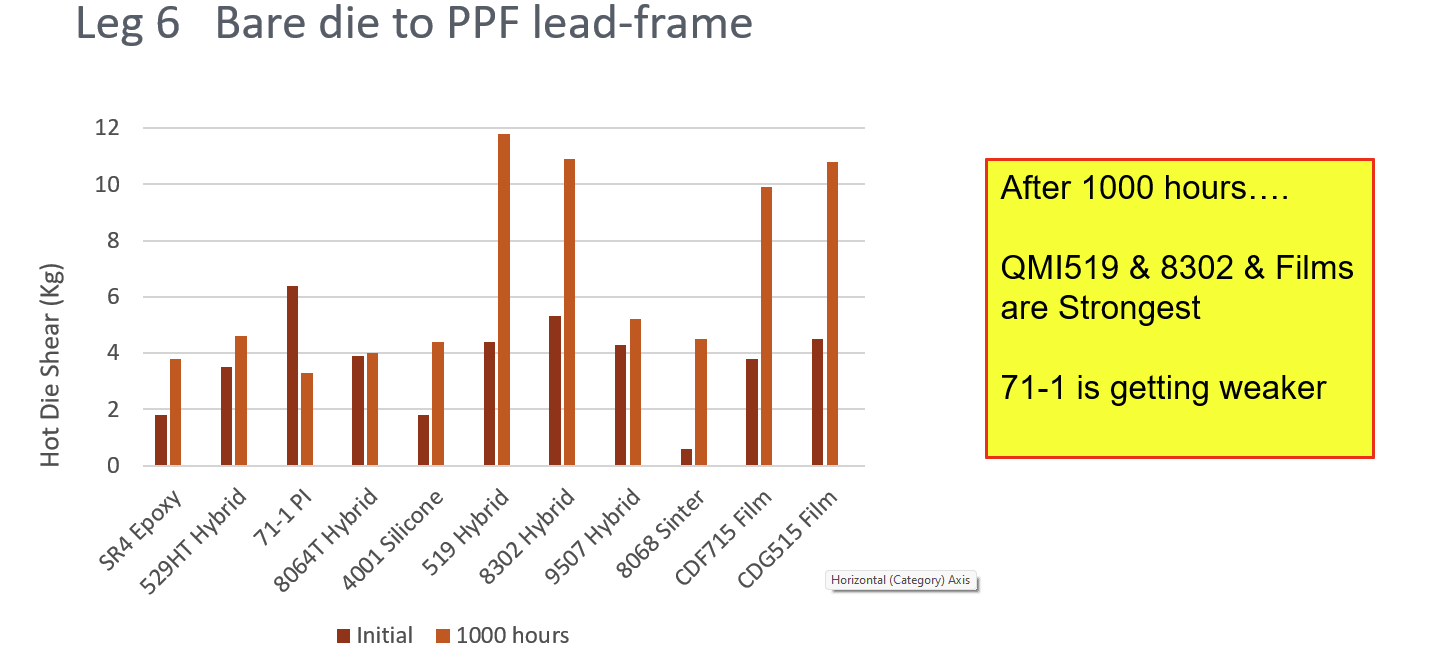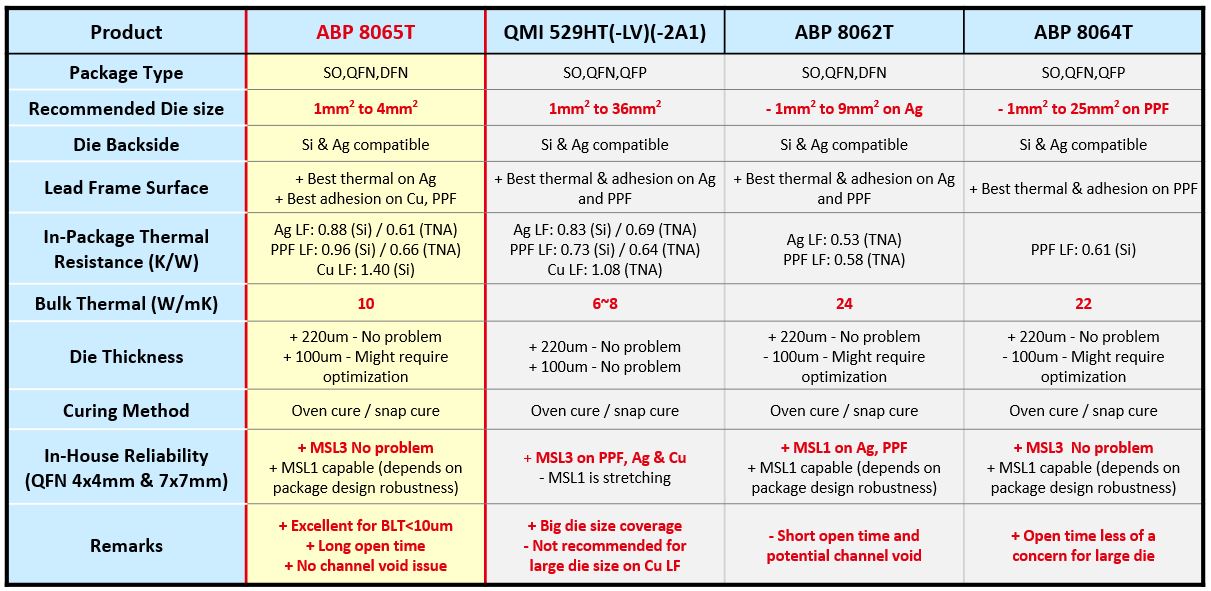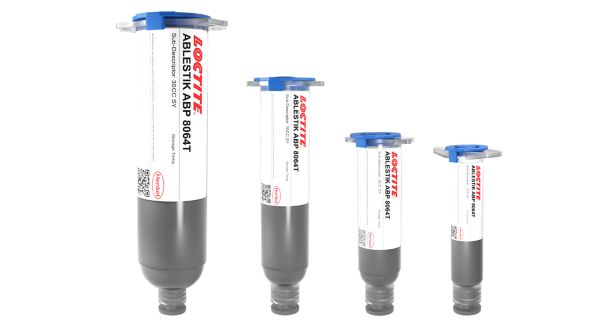LOCTITE ABLESTIK ABP 8064T
- Highest thermal conductivity
- Soft solder replacement
- Low outgassing
Product Description
LOCTITE ABLESTIK ABP 8064T highly filled, conductive die attach adhesive is designed to provide high thermal and electrical conductivity in the attachment of integrated circuits and components onto metallic leadframes. It boasts one of the highest thermal conductivities among die attach pastes (22 W/mK) only to be beaten by sintering technology.
LOCTITE ABLESTIK ABP 8064T is a 85% filled, soft solder replacement with low outgassing and medium modulus that is stable in High temperatures and can be used for a wide range of packages sizes. Typically it can be applied, among others, to QFP and High power devices.
Cure Schedule
- 60 min ramp from 25°C to 180°C, hold 60 mins at 180°C in N2 oven
- 60 min ramp from 25°C to 140°C, hold 60 mins at 140°C in N2 oven
Technical Specifications
| General Properties | |||||||||
| |||||||||
| Filler Content | 85 % | ||||||||
| Work life @25°C Work life @25°C Work life is the amount of time we have to work with a material until it is no longer able to be easily worked and applied on a substrate. It is based on the change in viscosity and it can rely on the application requirements. | 24 hours | ||||||||
| |||||||||
| Physical Properties | |||||||||
| Thixotropic index Thixotropic index Thixotropic Index is a ratio of a material s viscosity at two different speeds in Ambient temperature, generally different by a factor of ten. A thixotropic material s viscosity will decrease as agitation or pressure is increased. It indicates the capability of a material to hold its shape. Mayonnaise is a great example of this. It holds its shape very well, but when a shear stress is applied, the material easily spreads. It helps in choosing a material in accordance to the application, dispense method and viscosity of a material. | 5.8 | ||||||||
| Viscosity Viscosity Viscosity is a measurement of a fluid’s resistance to flow. Viscosity is commonly measured in centiPoise (cP). One cP is defined as the viscosity of water and all other viscosities are derived from this base. MPa is another common unit with a 1:1 conversion to cP. A product like honey would have a much higher viscosity -around 10,000 cPs- compared to water. As a result, honey would flow much slower out of a tipped glass than water would. The viscosity of a material can be decreased with an increase in temperature in order to better suit an application | 12,000 mPa.s | ||||||||
| Chemical Properties | |||||||||
| |||||||||
| Mechanical Properties | |||||||||
| |||||||||
| |||||||||
| Electrical Properties | |||||||||
| Volume Resistivity Volume Resistivity Volume resistivity, also called volume resistance, bulk resistance or bulk resistivity is a thickness dependent measurement of the resistivity of a material perpendicular to the plane of the surface. | 2.0x10-5 Ohms⋅cm | ||||||||
| Thermal Properties | |||||||||
| |||||||||
| Glass Transition Temperature (Tg) Glass Transition Temperature (Tg) The glass transition temperature for organic adhesives is a temperature region where the polymers change from glassy and brittle to soft and rubbery. Increasing the temperature further continues the softening process as the viscosity drops too. Temperatures between the glass transition temperature and below the decomposition point of the adhesive are the best region for bonding. The glass-transition temperature Tg of a material characterizes the range of temperatures over which this glass transition occurs. | 44.5 °C | ||||||||
| Thermal Conductivity Thermal Conductivity Thermal conductivity describes the ability of a material to conduct heat. It is required by power packages in order to dissipate heat and maintain stable electrical performance. Thermal conductivity units are [W/(m K)] in the SI system and [Btu/(hr ft °F)] in the Imperial system. | 22 W/m.K | ||||||||
Additional Information
Adhesion properties of ABP8064T

It's stated clearly in the TDS that it needs a N2 oven. Is this a prerequisite? Can it be cured in a conventional oven and if so how will this change the cure schedule?
Many customers prefer to cure in Nitrogen, to protect components from oxidation. However, please look at the 8064T data package – slide 33. It states that cure in Air or Nitrogen is OK. Justification data is on slides 30 to 32. It’s rather mathematical, but shows that die shear strength is not significantly affected by the curing atmosphere.
Would this epoxy be suitable to attach a Au plated copper tab to a Ag plated aluminium heatsink?
It is difficult to say. Our recommendation for 5mmx5mm max size is based on Silicon to Cu leadframe. (Expansion Coefficients are very different – 3ppm/C vs. 18ppm/C, so we get a lot of stress from this). However, you are bonding Copper (18 ppm/C) to Aluminium (23 ppm/C), so the expansion mismatch is smaller (about 5ppm/c vs 15ppm/C). So we would say that its worth trying ABP8064T





